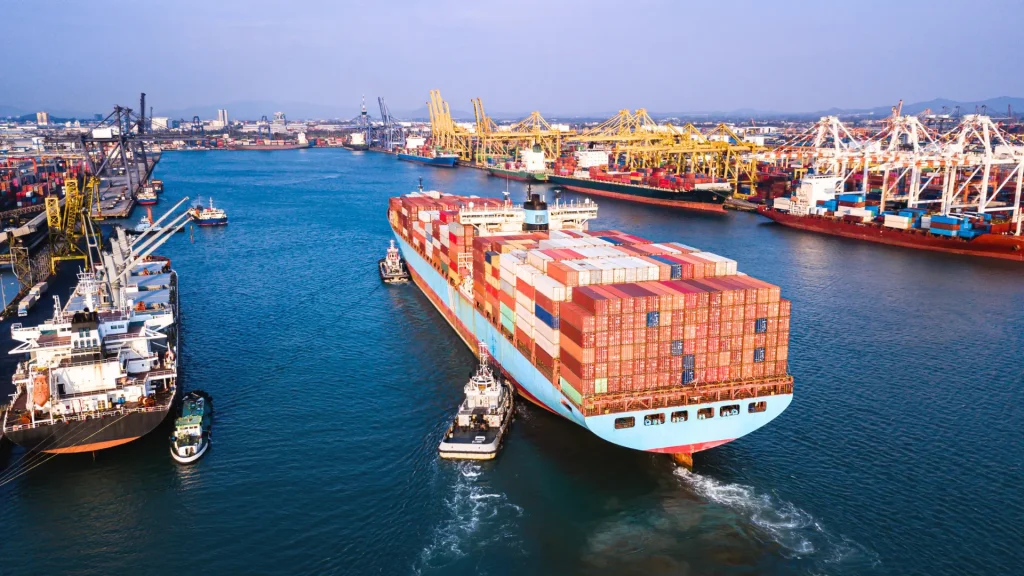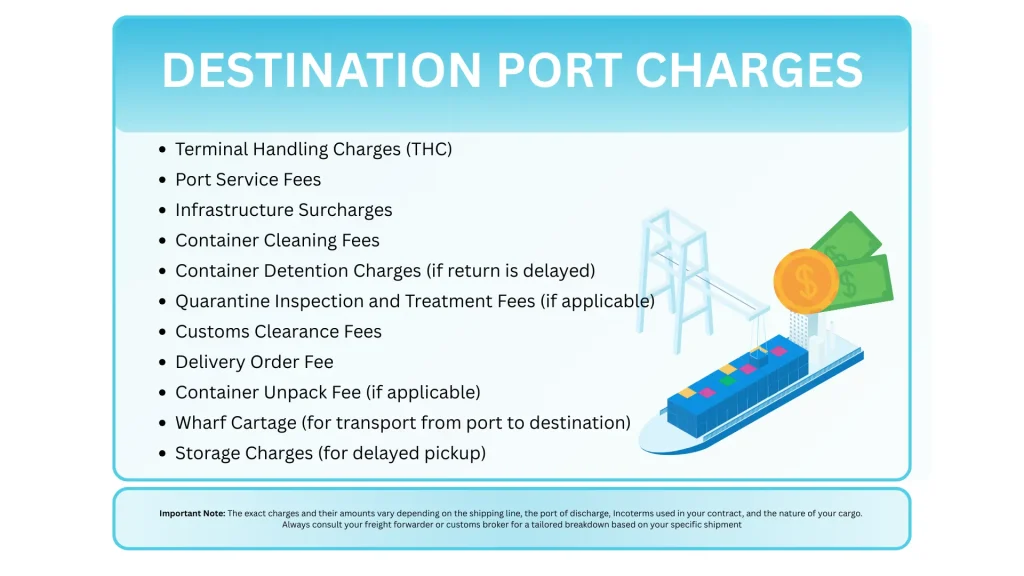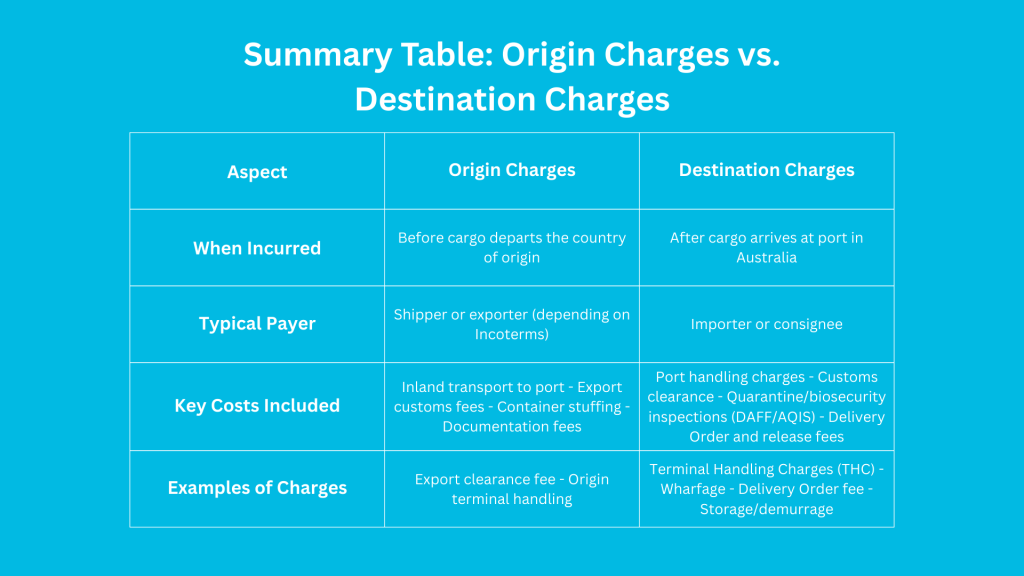Navigating the complexities of global shipping can feel like charting a course across vast oceans. However, for businesses engaged in global shipping, understanding every aspect of the journey is paramount. Indeed, while the base freight rate often takes center stage in initial shipping quotes, it’s crucial to recognise that this is just one piece of the puzzle. Consequently, businesses must also be keenly aware of the often-overlooked “destination port charges”, which are costs levied once your goods arrive at their final port.
These destination charges shipping, therefore, represent a vital component of the overall shipping expenses. Furthermore, a lack of awareness or a misunderstanding of these fees can unfortunately lead to unwelcome surprises, potentially derailing carefully planned budgets and causing frustrating delays in the supply chain. Moreover, for Australian businesses dealing with the unique geographical challenges and regulatory environment of international trade, a clear grasp of these charges is not just beneficial – it’s essential for maintaining profitability and ensuring smooth operations. Ultimately, by shedding light on these often-shadowy costs, businesses can gain greater control over their shipping expenses. And avoid those dreaded unexpected bills upon their goods’ arrival Down Under.

What Exactly Are Destination Charges?
So, what exactly are these ‘Destination Port Charges’ we’ve been talking about? Well, In global shipping, destination charges refer to the set of fees applied once your goods arrive at the destination port. Indeed, understanding these costs is of significant importance for any business involved in international trade, as they form an integral part of the total landed cost of goods.
What Do Destination Charges Include?
Destination port charges—also referred to as destination charges, or terminal dues—are levied by various parties involved in handling your cargo. These include:
- Shipping lines, for processing paperwork and releasing the container.
- Terminal operators, for unloading and storing the container.
- Customs authorities, for inspecting and clearing the goods for local entry.
Each of these charges is applied after the main international carriage ends, and they are usually billed to the importer or consignee.
Finally, it’s important to keep in mind that the specific types and amounts of these charges are not uniform across the globe. Instead, they are very much dependent on the particular destination country and the specific port within that country where your goods arrive.
In summary, destination charges:
- Are fees incurred at the port of arrival.
- Are levied by carriers, terminal operators, or customs authorities.
- Cover the costs of processing, handling, and releasing shipments.
- Occur after the main international transit.
- Vary based on the destination country and port.
How to Calculate Destination Port Charges
Calculating destination port charges can be complex, yet understanding how these fees are structured is essential for avoiding unexpected costs. Because these charges are not included in the freight rate, Australian importers and exporters must account for them separately. Therefore, following a clear, step-by-step process helps businesses estimate these charges more accurately.
Understand the Key Components of Terminal dues
Firstly, it’s essential to familiarise yourself with the common elements that contribute to destination charges in Australia. These can include:
• Security Charges:
Additionally, ports in Australia, like around the world, often have security measures in place. Thus, security charges may be levied to cover the costs associated with these measures, ensuring the safety and integrity of the cargo and the port facility.
• Storage Fees (Demurrage and Detention):
Furthermore, if your cargo remains at the terminal beyond a certain free time period, you will likely incur storage fees. To clarify, demurrage typically refers to the charges for the use of the terminal space beyond the allotted free days. While detention usually applies to charges for holding onto the shipping container outside the terminal for longer than agreed. Therefore, prompt pickup of your goods is crucial to avoid these potentially significant costs.
• Wharfage/Port Service Charges:
Moreover, the port authority in Australia will levy charges for the use of the wharf and other port facilities. Consequently, these fees, often referred to as wharfage or port service charges, contribute to the upkeep and operation of the port.
• Documentation Fees:
In addition to customs documentation, there may be other administrative fees for processing the necessary paperwork at the destination. Hence, these documentation fees cover the carrier’s or agent’s costs for handling these essential documents.
• Delivery Order (DO) / Release Fees:
Before you can take possession of your goods, the shipping line or their agent will issue a delivery order. Therefore, a fee is often associated with the processing and release of this crucial document, which authorises the terminal to release your cargo.
• Quarantine and Biosecurity Inspection Fees:
Given Australia’s strict biosecurity regulations, goods arriving in the country are subject to inspection by the Department of Agriculture, Fisheries and Forestry (DAFF). Consequently, these quarantine and biosecurity inspection fees cover the costs of these essential checks to protect Australia’s unique environment and agricultural industries.
• Inland Transportation Arrangement Fees:
If the cargo moves further inland, there may be coordination or handling fees beyond the port.
• Additional Charges:
Finally, depending on the specific circumstances, other charges might apply. For instance, if the importer is responsible for container cleaning or repairs, these costs would be added to the destination charges.

Consider the Factors That Affect Destination Charges
Secondly, understanding the factors that can cause destination charges to fluctuate is just as important as knowing the individual components. These key factors include:
- Type of Goods Being Shipped: The nature of your cargo significantly impacts handling requirements and associated fees. For example, perishables will require specialised handling and temperature-controlled storage. While hazardous materials necessitate strict safety protocols and may incur additional charges.
- Weight and Volume of the Shipment: Many destination charges, particularly THC and storage, are calculated based on either the gross weight or the cubic meter of your shipment, whichever is greater. This “greater of” rule ensures that charges reflect either the physical space occupied or the actual weight handled.
- Shipping Route and Carrier: The specific shipping route and the carrier you choose, along with their logistics provider in Australia, can influence the destination charges. Different carriers and agents have their own tariff structures and service fees.
- Local Regulations and Port Authority Tariffs in Australia: Destination charges are inherently tied to the local regulations and the tariffs set by the Australian port authorities. These regulations and tariffs can change over time, so staying informed is crucial. While destination charges are not the import duties or taxes themselves, they can include fees related to the processing of these payments.
- Specific Services Required at the Destination: If your shipment requires special handling (e.g., out-of-gauge handling, specialised inspections, or surveys), extra costs apply.
Real-World Examples in Australian Ports
Australian destination port charges vary depending on whether your cargo is shipped as a full container load (FCL) or as less-than-container load (LCL). Below are examples and explanations for FCL:
Port charges for full containers are typically itemised per container size and port. For example, the following are typical import port charges for major Australian ports (Melbourne):
Charge Type | 20′ Container (AUD) | 40′ Container (AUD) |
Import Port Service Charge | 620 | 840 |
Depot Handling Charge | 85 | 85 |
Import Delivery Order Fee | 120 | 120 |
Please Note: The destination port charges provided above are estimates only. The actual fees you will incur can vary significantly depending on several factors, including:
- The specific shipping line or carrier you choose, as each will have its own tariff structure.
- The exact type of cargo being shipped (e.g., general, refrigerated, hazardous), as this can affect handling requirements and associated costs.
- The specific port of arrival within Australia, as different ports have varying fee schedules.
- The prevailing local regulations and port authority tariffs at the time of arrival, which are subject to change.
- Any additional services you might require at the destination.
Therefore, it is crucial to obtain a detailed and specific quotation from your chosen shipping line or freight forwarder.
Who Pays Destination Port Charges?
So, who ultimately foots the bill for these destination charges we’ve been discussing?
Typically, the Importer Pays
Generally speaking, the responsibility for payment typically falls upon the importer (the buyer of the goods) or the consignee (the party to whom the goods are shipped) once the goods arrive in Australia. However, like many aspects of international trade, the specifics are determined by the Incoterms agreed upon by the buyer and the seller in their sales contract.
Sometimes the Shipper or Forwarder Covers It
Under specific shipping arrangements, the shipper or freight forwarder may cover destination charges on behalf of the importer.
For instance, under Delivered Duty Paid (DDP) terms, the seller assumes almost all responsibilities and costs. Also including those incurred at the destination port and even the import duties and taxes in Australia. Consequently, in such cases, this cost is usually factored into a higher overall shipping quote provided to the buyer upfront.
Incoterms Determine Responsibility
The Incoterms (International Commercial Terms) clearly define who pays what along the shipping process. Here’s how different terms apply:
- EXW (Ex Works): Under these terms, the buyer assumes responsibility for all costs and risks from the seller’s premises, meaning the importer is responsible for all origin and destination charges, including those in Australia.
- FOB (Free on Board): Once the goods pass the ship’s rail at the port of origin, the buyer takes on all costs and risks. Therefore, the Australian importer is responsible for all destination charges.
- CIF (Cost, Insurance and Freight): The seller pays for the cost, insurance, and freight to the named port of destination in Australia. However, the buyer typically becomes responsible for the destination charges once the goods arrive.
- DAP (Delivered at Place): The seller is responsible for arranging and paying for transportation to the named place in Australia. However, the buyer is usually responsible for unloading the goods and all subsequent destination charges.
- DDP (Delivered Duty Paid): As mentioned earlier, the seller bears almost all costs, including transportation to the named place in Australia, all destination charges, and even import duties and taxes.
Why This Must Be Clear in Contracts
- Firstly, clearly identifying who pays destination charges is vital to avoid confusion or costly disputes.
- Moreover, it ensures that no party is caught off guard when the cargo reaches an Australian port.
- Therefore, always confirm the Incoterms used and include a breakdown of responsibilities in your sales contract or commercial invoice.
What is the Difference between Origin Charges and Destination Charges?
In international shipping, understanding the difference between origin charges and destination charges is essential for managing costs effectively. Although both sets of fees are part of the overall logistics process, they apply at different stages of the journey and are usually paid by different parties.
What Are Origin Charges?
Origin charges refer to the costs incurred at the point of origin, before the shipment leaves the exporting country. These charges usually include expenses related to export documentation, customs clearance, container loading, and inland transportation to the port. Therefore, they cover various activities required to prepare the goods for export and get them onto the international carrier.
What Are Destination Charges?
In contrast, destination charges apply after the shipment arrives at the destination port — such as Sydney, Melbourne, or Brisbane in Australia. These fees include costs related to unloading, handling, customs clearance, quarantine inspections, and final delivery arrangements.
Key Differences Between Origin and Destination Charges
- Timing of the Charges:
Origin charges happen before the international carriage, while destination charges occur after arrival.
- Who Typically Pays:
Origin charges are usually paid by the shipper or exporter, depending on the Incoterms used. While destination port charges are often the responsibility of the importer or consignee.
- What They Cover:
- Origin Charges Cover Pre-Shipment Activities: Firstly, these include tasks such as inland transportation of the goods from the seller’s premises to the port of export. Moreover, origin charges cover export customs clearance procedures and documentation in the country of origin. Additionally, loading the goods onto the international carrier (e.g., vessel or aircraft), and terminal handling charges at the port of export.
- Destination Charges Cover Post-Shipment Activities: Usually, these encompass activities that take place upon arrival in Australia. For example unloading the goods from the international carrier, terminal handling at the Australian port. Furhtermore, these charges cover import customs clearance procedures and fees, quarantine and biosecurity inspections. Finally, terminal dues include storage if necessary, documentation fees at the destination, and the delivery order or release fees.
To further clarify these differences, here’s a table summarising common examples of both types of charges:

Australian-Specific Information and Regulations
For businesses engaged in importing or exporting goods to or from Australia, a keen understanding of the country’s unique regulatory landscape is paramount, as it directly impacts destination charges. Several Australian-specific regulations and charges can add to the overall cost and processing time.
Beyond the standard destination charges, businesses importing into Australia need to be particularly aware of the following:
• Biosecurity Charges.
Firstly, As of May 2025, the Biosecurity Protection Levy Bills were withdrawn in February 2025. The funding mechanism for biosecurity is currently under review. While the previous Biosecurity Import Levy rates were indeed AUD 45.00 for air cargo and AUD 66.00 for sea cargo, it’s crucial to note the recent legislative changes. Businesses should refer to the Department of Agriculture, Fisheries and Forestry (DAFF) website for the most current information on biosecurity charges.
• Customs Clearance Fees.
Secondly, these encompass fees charged by customs brokers in Australia for their services in preparing and lodging import declarations, liaising with the ABF, and ensuring compliance. These fees vary depending on the complexity of the shipment and the broker’s rates.
• Specific Port Levies and Infrastructure Charges.
Finally, major Australian ports have various infrastructure and service charges. For example, as of July 2024, the Port of Brisbane’s charges include an Import Port Service Charge of approximately AUD 46.60 per TEU for full containers, along with Wharfage and Harbour Dues. Stevedores at major ports like Melbourne, Sydney, Brisbane, and Fremantle also levy Terminal Access Charges (TACs) and Vehicle Booking System (VBS) fees, which have seen increases in early 2025. For instance, average TACs increased by around 9% for full imports in early 2025 across major stevedores. Flinders Terminal in Adelaide increased its Port Infrastructure Levy to AUD 245.00 per container in April 2024. These charges contribute to port maintenance and development.
Important Note: Destination charges and Australian import regulations are subject to change. The information provided reflects the latest available data as of May 2025. Businesses must always verify the most current fees and rules with the Department of Agriculture, Fisheries and Forestry (DAFF) for biosecurity, the Australian Border Force (ABF) for customs, individual Australian port websites, and their freight forwarders or customs brokers. Relying on past data can lead to inaccurate costs.
Tips and Best Practices for Managing Destination Charges
Effectively managing destination charges requires a proactive and informed approach. Therefore, here are some actionable tips tailored for Australian businesses involved in global shipping:
- Partner with Experienced Freight Forwarders or Customs Brokers in Australia
Firstly, their up-to-date local knowledge of ABF and DAFF regulations, electronic systems, and port-specific charges is crucial for accurate declarations and smooth clearance.
- Demand Complete Transparency and a Detailed Breakdown in AUD
Additionally, obtain comprehensive quotes with all potential destination charges itemised in Australian Dollars (AUD), reflecting current rates and fees.
- Thoroughly Understand the Implications of Incoterms
Moreover, ensure your sales contracts clearly define responsibility for all costs, including destination charges in Australia, based on the latest Incoterms.
- Prioritise Accurate and Timely Electronic Declarations
Consequently, ensure your customs brokers are utilising the latest ABF electronic systems correctly. Moreover, make sure they provide all required information to minimise delays and potential penalties.
- Plan for Biosecurity Inspections and Potential Treatments
Furthermore, understand DAFF’s requirements for your specific goods and factor in potential inspection times and treatment costs to avoid unexpected delays and expenses.
- Negotiate with Shipping Lines and Agents
Where possible, explore options for all-inclusive rates or capping certain destination charges, particularly terminal handling and documentation fees.
- Consolidate Shipments Where Possible
In many cases, for LCL cargo, consolidation can reduce per-unit destination charges, especially for handling and documentation.
- Ensure Timely Pickup of Goods
To avoid extra costs, arrange prompt pickup of cleared goods from the terminal to prevent escalating demurrage and detention charges.
- Stay Continuously Informed
Finally, regularly monitor official websites of the Australian Border Force, the Department of Agriculture, Fisheries and Forestry (https://www.agriculture.gov.au/), and reputable industry associations for the latest regulatory updates, fee changes, and system modifications.
Conclusion:
As we’ve explored, destination port charges are the diverse fees levied upon arrival, encompassing elements such as terminal handling, customs clearance, security, storage, wharfage, documentation, delivery order processing, and Australia’s unique biosecurity and quarantine inspections. Furthermore, the responsibility for these payments hinges on the agreed-upon Incoterms, with the importer or consignee typically bearing the brunt, although exceptions exist. It’s also crucial to differentiate these destination charges from origin charges, which are incurred before the shipment even departs.
Therefore, the critical importance of understanding and proactively managing destination charges cannot be overstated. For Australian businesses operating in the global marketplace, a lack of awareness can lead to unexpected costs, operational delays, and ultimately, reduced profitability. By taking the time to dissect these charges, understand the influencing factors, and stay informed about Australian-specific regulations and fees, businesses can gain greater control over their supply chains and ensure cost-effectiveness.
Finally, if you find yourself with further questions or need a reliable freight forwarding partner, please do not hesitate to reach out to the experienced team at GenFreight. We are here to help streamline your international trade and ensure a seamless shipping experience.
